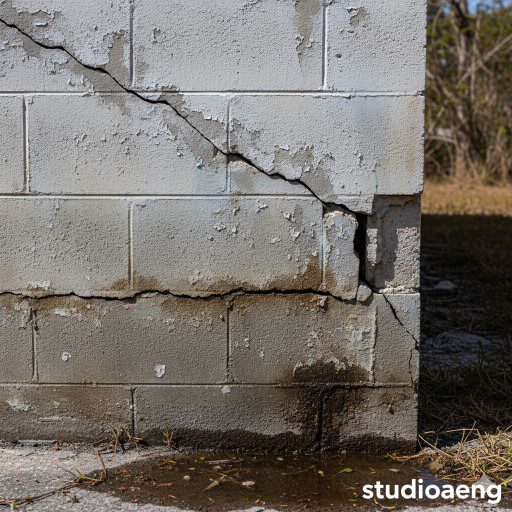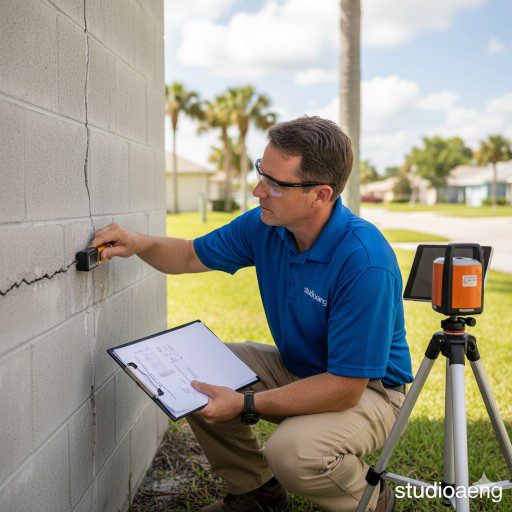Found a Crack in Your Foundation? When to Call a Structural Engineer in Florida
Discovering a crack in your home’s foundation can be a stressful experience, immediately bringing to mind worst-case scenarios and costly repairs. However, not all cracks are a sign of a structural emergency. The most important step you can take is to get a professional cracked foundation inspection to determine the severity of the issue.
This guide will help you identify the warning signs of a serious problem, explain what happens during a professional inspection, and clarify why a licensed structural engineer is the only person you should trust for the job.
Table of Contents
Not All Cracks Are Created Equal: What to Look For
The type, size, and direction of a crack can tell an expert a lot about its cause. Here are some general guidelines to help you assess the situation.
Signs of Minor Settlement Cracks
Small, thin cracks are often a normal part of a home’s aging process as it settles. These are typically not a cause for immediate alarm.
- Hairline Cracks: Very thin cracks (less than 1/8 inch wide).
- Vertical Cracks: Cracks that run straight up and down and are consistent in width.
- No Water Intrusion: The cracks are dry and show no signs of moisture seeping through.


5 Urgent Warning Signs of a Serious Problem
If you see any of the following, it is a strong indication that you need a professional cracked foundation inspection as soon as possible.
- Horizontal Cracks: Cracks that run sideways along a foundation wall are a major red flag, often indicating pressure from the soil outside.
- Stair-Step Cracks: Cracks that run in a stair-step pattern in concrete block or brick walls suggest serious movement.
- Wide Cracks: Any crack wider than 1/4 inch should be evaluated by a professional.
- Uneven Sides: If one side of the crack is higher than the other, it indicates significant shifting.
- Water Intrusion: If water is seeping through a crack, it must be addressed to prevent further damage and mold growth.
What Happens During a Professional Cracked Foundation Inspection?
A professional inspection is a systematic process to diagnose the root cause of the problem. It typically involves:
- A Full Visual Assessment: The engineer will inspect the entire foundation, both inside and out, as well as look for secondary signs of movement like sticking doors or cracks in drywall.
- Measurement and Documentation: The engineer will measure the width, length, and displacement of all significant cracks.
- Root Cause Analysis: The ultimate goal is to determine why the foundation is cracking. Is it soil settlement, water pressure, or a construction issue? A proper cracked foundation inspection identifies the source of the problem.
- A Formal Engineering Report: You will receive a detailed report with the engineer’s findings and, if necessary, a recommended plan of repair. This report is a crucial document for any future work.

Why a Structural Engineer is Essential
While a foundation repair contractor can fix a crack, only a Licensed Professional Engineer can provide an unbiased diagnosis and design a guaranteed, code-compliant solution. An engineer works for you, not for the repair company. Their job is to provide the correct plan of action, which you can then take to qualified contractors for bids. This ensures the repair is not just a patch, but a permanent solution based on sound structural engineering principles. For more on professional engineering standards, you can visit the American Society of Civil Engineers (ASCE).
Don’t Guess About Your Foundation’s Safety
A crack in your foundation is a problem that should never be ignored. Getting a professional cracked foundation inspection provides peace of mind and a clear path forward.
Contact us today to schedule an assessment with a licensed structural engineer and protect your most valuable investment.
